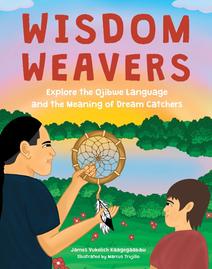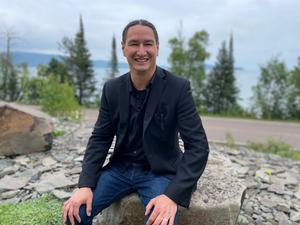
|

|
Two-time Sibert Medal winner and Boston-Globe Horn Book Award honoree Traci Sorell writes inclusive historical and contemporary fiction and nonfiction for young people. Her books include We Are Grateful: Otsaliheliga, At the Mountain's Base, and Mascot. A former federal Indigenous law attorney and policy advocate, Sorell is a Cherokee Nation citizen and first-generation college graduate. She lives within her tribe's reservation in northeastern Okla.
James Vukelich Kaagegaabaw, a descendant of Turtle Mountain, is an international speaker, author, educator, and social media personality who shares Indigenous wisdom for a life well lived. His keen insights were developed through speaking with and recording elders and native language speakers across North America as part of the Ojibwe Language Dictionary Project. He lives in Minnesota's Twin Cities.
Here, Sorell and Kaagegaabaw discuss their 2024 titles, Clack, Clack! SMACK! (Charlesbridge, $17.99) and Wisdom Weavers (Quarto, $18.99), respectively, and the importance of publishing books for children in Indigenous languages.
Traci Sorell: Siyo, hi, James!
James Vukelich Kaagegaabaw: Boozhoo, hello, Traci!
Sorell: I'm delighted to visit with you about Wisdom Weavers. I love that the picture book centers on a dream catcher, which is probably the most recognizable (at least to non-Ojibwe people) item of Ojibwe culture. What was the story's genesis?
Kaagegaabaw: I wanted to share the story of taking my son out to harvest red willow. This happened during the pandemic, and I wanted to record that unique and special time in our lives. I also really wanted to share cultural topics like the Seven Grandfather teachings, the Ojibwe name for a dream catcher, and some of the stars and constellations in Ojibwe.
Sorell: I love that Wisdom Weavers captures a special time for you and your son, then brings it forward with more cultural and linguistic teachings for everyone. I initially wondered if your focus was to debunk the common misunderstanding that dream catchers are just a "Native" cultural item. I loved the deep dive into its Ojibwe cultural significance; it's important to show young people that while Native Nations have many commonalities, we also have distinct languages, cultural practices, and worldviews. So wado, thank you, for shining a light on that.
I appreciated having the QR codes on the page to provide the pronunciation of the Ojibwe words. Was that your idea or something that came up during the book design phase? Did you plan to have the other Ojibwe words shown on each double page spread or were those selected after you saw Marcus Trujillo's illustrations?

|
|
| James Vukelich Kaagegaabaw | |
Kaagegaabaw: Miigwech, thank you! We chose to use QR codes as the book developed. I was excited to be able to share the language and to give parents and educators an opportunity to hear and use the language, either in a classroom setting or at storytime. The QR codes are nice because it doesn't place the responsibility of correct pronunciation on the educator or parent. They can simply scan with their phone and listen to an authentic pronunciation of the Ojibwe words.
We actually developed the vocabulary for each spread before Marcus came up with the illustrations. It's a testament to his outstanding work that he was able to incorporate all the vocabulary words in his illustrations in such a beautiful way.
I really enjoyed seeing the Cherokee perspective of lacrosse in Clack, Clack! SMACK! Many Woodland Nations still play both traditional and competitive lacrosse--why did you select that game for your book?
 |
|
| Traci Sorell (photo: Cody Hammer) |
|
Sorell: I wanted to push back on the mainstream culture messaging in this country of individualism, being "the hero" and winning. In Cherokee culture, our teachings focus on the collective and using our gifts and abilities to help and care for others. We have a social stickball game that our kids play in PE class at our language immersion school, in our communities, and at ceremonial grounds. Certainly, we're competitive and the game can be rough, but the focus is on the team and not the individual. In Clack, Clack! SMACK!, Vann is a child who is taller and more muscular, so one would think he's coordinated and super-fast. But he's not. I think this game is a wonderful way to help young people see that contributing in any way is what's important.
Kaagegaabaw: Did you have to research the stickball words in Cherokee for this book?
Sorell: When Cherokee stickball players are on the field, they use our language to communicate. So, I didn't want the characters speaking English. I contacted a few friends who play stickball regularly and asked what would be said in each scene. I worked with John Ross, a Cherokee first language speaker, to ensure that I got the syllabary correct, as well as the English phonetics shown in the main text. I love the community one finds across Native Nations that is willing to assist in helping a story be culturally accurate as well as centered on the Indigenous folks featured in it. There's also an all-Cherokee syllabary version translated by Mr. Ross for Cherokee language speakers and learners that's available in e-book format. I'm super excited about that!
Kaagegaabaw: That's great news that there is a Cherokee version of your book! When I taught at an Ojibwe immersion program, it was so important to have children's books written in the language. There is a considerable shortage of books in our languages.
Was the translation into Cherokee difficult? Sometimes the languages are so different.
Sorell: I agree that we need more books written in our languages. As we look at growing first language learners within the Cherokee Nation from babies, we have a couple of programs that rely on first language speakers and materials created by the tribe's translation department. I'd love to see more beautifully illustrated board books, picture books, and chapter books in the Cherokee syllabary.
The Cherokee language bears no resemblance to English at all. It's about 80% verbs. It's polysynthetic, meaning that what looks like a single word can be an entire sentence. For example, "otsaliheliga" is the sentence "We are grateful" in English. There are prefixes and suffixes added to the root verb. There are also ways to describe something based on what state it is in, e.g., a solid, liquid, gas, etc., that English doesn't have. So, it's not translating the text, but rather thinking and seeing what is communicated in a Cherokee worldview. That's why having a first language speaker who also does freelance translation work for publishers is SO helpful. Mr. Ross does understand both worlds, which are very different.
Kaagegaabaw: Yes, in my keynotes I point out that Ojibwe, Dakota/Lakota/Nakota and Haudenoshaunee are as different from each other, comparatively speaking, as German, Mandarin Chinese, and Somali--three different languages spoken on three different continents by three different nations of people.
Sorell: Great point! So, how did your language learning come about? I've seen you sharing on social media. Do you also formally teach the language?
Kaagegaabaw: I began learning the Ojibwe language at age 25. My mother, uncles, and grandmother all went to boarding and residential schools, so they had little to no access at all to the language, culture, history, and spirituality. I was fortunate to have the opportunity to learn from fluent first language speakers, professors, elders, medicine people, and hereditary Chiefs, as well as the world's leading linguistic expert in the language. I worked as an Ojibwe educator (pre-k through university) for the past two decades, but now I am exclusively speaking, writing, and creating content for my various social media platforms.
Sorell: What are you working on next?
Kaagegaabaw: I don't have any new books publishing right now but I'll continue making videos based on the Ojibwe language for my YouTube Channel and other social media platforms. How about you?
Sorell: I have an acrostic poem in the Banned Together young adult anthology coming out in Spring 2025 and books coming in 2026. My focus is definitely to keep centering and incorporating the Cherokee language into my work.
Kaagegaabaw: Miigwech, Traci. It is so nice to meet you!
Sorell: Wado, James! I have enjoyed learning more about you and your commitment to sharing the Ojibwe language and culture. Our languages, our culture, and our ways of being continue to be part of our lives in this complicated, modern world. Miigwech!

